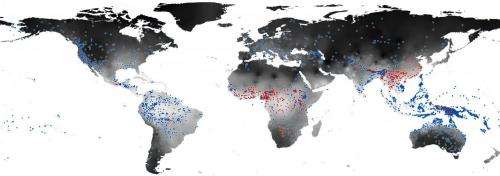Tonal languages require humidity

The weather impacts not only upon our mood but also our voice. An international research team including scientists from the Max Planck Institutes for Psycholinguistics, Evolutionary Anthropology and Mathematics in the Sciences has analysed the influence of humidity on the evolution of languages. Their study has revealed that languages with a wide range of tone pitches are more prevalent in regions with high humidity levels. In contrast, languages with simpler tone pitches are mainly found in drier regions. This is explained by the fact that the vocal folds require a humid environment to produce the right tone.
The tone pitch is a key element of communication in all languages, but more so in some than others. German or English, for example, still remain comprehensible even if all words are intonated evenly by a robot. In Mandarin Chinese, however, the pitch tone can completely change the meaning of a word. "Ma" with a level pitch means "mother," while "ma" with a falling then rising pitch would mean "horse". "Only those who hit the tone pitch correctly can express themselves in tonal languages," explains Seán G. Roberts, a scientist at the Max Planck Institute for Psycholinguistics in Nijmegen.
However, the climate can become a problem for the speakers of tonal languages, as the vocal folds in the larynx – commonly known as the voice box – suffer as a result. Even a temporary increase in humidity impacts upon the vocal folds: The humidity keeps the mucous membranes moist and makes them more elastic. It also changes the ion balance within the mucous membranes of the vocal folds. With good humidity, the vocal folds can oscillate sufficiently and produce the right tone.

The scientists therefore suspect that tonal languages are less common in dry regions as the wide range of tonal pitches is difficult to produce under these conditions and are more likely to result in misunderstanding. "Modern databases enable us to analyse the properties of thousands of languages. But this also brings problems because languages can also inherit their complex pitches from another language," says Damián E. Blasi, who conducts research at the Max Planck Institutes for Mathematics in the Sciences and for Evolutionary Anthropology in Leipzig. In their study, the scientists have now shown that these effects can be disentangled from the effects of climate.
The researchers investigated the correlation between humidity and the significance of tone pitch in over 3,750 languages from different linguistic families. This indicates that tonal languages are significantly rarer in dry regions. In relatively dry Central Europe, no tonal languages have developed like those found in the Tropics, Subtropical Asia and Central Africa.
Climate apparently shapes the role of pitch tone in a language and therefore how information is exchanged. Even small effects may be amplified over the generations to produce a global pattern. The climate thus determines the development of languages. "If the UK had been a humid jungle, English may also have developed into a tonal language," explains Roberts.
More information: "Climate, vocal folds, and tonal languages: Connecting the physiological and geographic dots." PNAS, 19 January 2015. DOI: 10.1073/pnas.1417413112
Journal information: Proceedings of the National Academy of Sciences
Provided by Max Planck Society
















